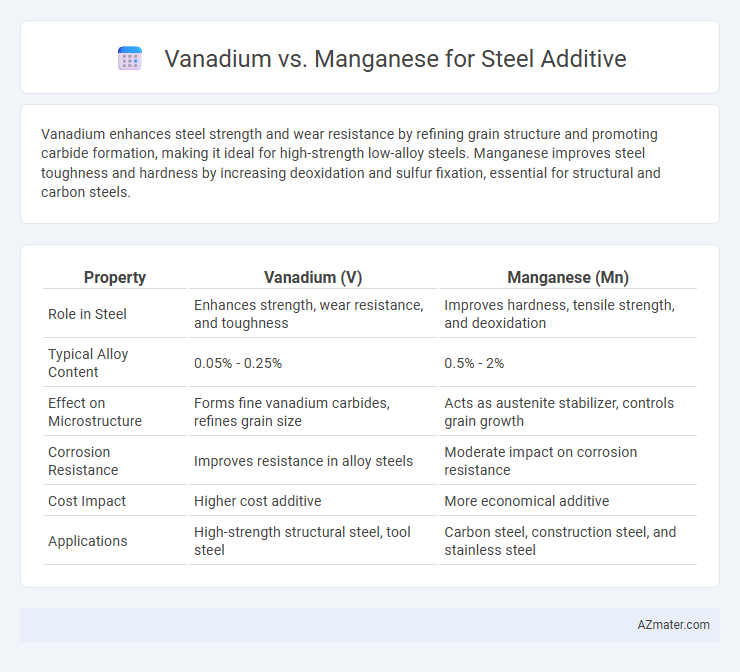Vanadium enhances steel strength and wear resistance by refining grain structure and promoting carbide formation, making it ideal for high-strength low-alloy steels. Manganese improves steel toughness and hardness by increasing deoxidation and sulfur fixation, essential for structural and carbon steels.
Table of Comparison
| Property | Vanadium (V) | Manganese (Mn) |
|---|---|---|
| Role in Steel | Enhances strength, wear resistance, and toughness | Improves hardness, tensile strength, and deoxidation |
| Typical Alloy Content | 0.05% - 0.25% | 0.5% - 2% |
| Effect on Microstructure | Forms fine vanadium carbides, refines grain size | Acts as austenite stabilizer, controls grain growth |
| Corrosion Resistance | Improves resistance in alloy steels | Moderate impact on corrosion resistance |
| Cost Impact | Higher cost additive | More economical additive |
| Applications | High-strength structural steel, tool steel | Carbon steel, construction steel, and stainless steel |
Overview of Vanadium and Manganese in Steel Production
Vanadium enhances steel strength, toughness, and wear resistance by forming stable carbides and nitrides, while manganese improves hardness, strength, and ductility by acting as a deoxidizer and sulfur fixer. Vanadium's microalloying effect refines grain structure for high-strength low-alloy (HSLA) steels, whereas manganese is essential in controlling steel's deoxidation and enhancing hot-working properties. Both elements are critical in optimizing mechanical properties, with vanadium primarily used for high-strength applications and manganese serving as a fundamental additive in most steel grades.
Chemical Properties and Functions in Steel
Vanadium enhances steel's strength and hardness by forming stable carbides and nitrides, which refine grain structure and improve wear resistance. Manganese acts mainly as a deoxidizer and sulfur fixer, improving toughness and ductility by counteracting brittleness caused by sulfur impurities. Both elements contribute to steel's mechanical properties but vanadium is critical for high-strength applications, while manganese is essential for structural stability and machinability.
Impact on Steel Strength and Hardness
Vanadium significantly enhances steel strength by promoting fine grain structure and forming hard vanadium carbides, which improve wear resistance and toughness. Manganese increases hardness primarily through solid solution strengthening and by improving steel's hardenability, making the metal more resistant to deformation. Vanadium typically results in higher tensile strength and better overall toughness compared to manganese, which is more effective for wear resistance and ductility balance in alloy steels.
Influence on Ductility and Toughness
Vanadium enhances steel ductility and toughness by refining the grain structure and promoting precipitation strengthening, which improves resistance to impact and fatigue. Manganese increases toughness by improving hardenability and reducing brittleness while also enhancing ductility through its role as a deoxidizer and sulfur fixer. Both elements contribute to critical mechanical properties, but vanadium's microalloying effect typically results in superior toughness and finer grain size compared to manganese.
Corrosion Resistance and Durability Enhancements
Vanadium significantly enhances steel's corrosion resistance by forming stable carbides that improve grain refinement and reduce susceptibility to oxidation, outperforming manganese in these aspects. Manganese primarily increases hardness and tensile strength but offers limited improvements in corrosion resistance compared to vanadium. The durability of steel is notably improved with vanadium additives due to enhanced wear resistance and fatigue strength, making it more suitable for environments prone to corrosion and mechanical stress.
Effects on Steel Weldability and Fabrication
Vanadium enhances steel weldability by refining grain structure and improving toughness, making it ideal for high-strength low-alloy steels and reducing the risk of weld cracking during fabrication. Manganese increases steel hardness and tensile strength while promoting deoxidation, but excessive amounts can lead to increased brittleness and welding difficulties. Optimizing the balance between vanadium and manganese content is crucial for achieving superior weldability and fabrication performance in steel alloys.
Cost Comparison: Vanadium vs Manganese Additives
Vanadium additives in steel typically incur higher costs than manganese due to vanadium's scarcity and complex extraction processes, with prices averaging around $30 per kilogram compared to manganese's $2-4 per kilogram. Despite the cost disparity, vanadium's superior strength enhancement and improved wear resistance justify its premium in high-performance steel alloys. Manganese remains the economically preferred choice for general structural steel applications, balancing affordability and essential deoxidizing and alloying properties.
Environmental and Safety Considerations
Vanadium and manganese are critical steel additives, with vanadium enhancing strength and wear resistance while manganese improves toughness and deoxidation. Vanadium production poses higher environmental risks due to energy-intensive extraction and potential toxic byproducts, whereas manganese mining generally results in lower emissions but may cause localized ecological disruption. Both metals require careful handling to mitigate occupational hazards such as dust inhalation and chemical exposure, with vanadium needing stricter controls due to its higher toxicity levels.
Typical Industrial Applications and Use Cases
Vanadium is primarily used in high-strength low-alloy (HSLA) steels to enhance toughness, wear resistance, and fatigue strength in automotive components, construction beams, and pipeline materials. Manganese is essential for improving hardness and tensile strength in carbon steels, commonly applied in rail tracks, structural steel, and rebar for concrete reinforcement. Both elements serve crucial roles in steel manufacturing, with vanadium favored for performance-critical applications and manganese dominating in cost-effective, large-scale steel production.
Choosing the Right Additive for Optimal Steel Performance
Vanadium significantly enhances steel strength, toughness, and wear resistance by promoting fine-grain steel microstructures and carbide formation, making it ideal for high-strength applications. Manganese improves steel hardness and tensile strength while counteracting brittleness by acting as a deoxidizer and sulfur fixer, essential for weldability and toughness. Selecting the right additive depends on the specific steel grade and desired mechanical properties, with vanadium preferred for high-performance alloys and manganese favored for balanced strength and ductility.

Infographic: Vanadium vs Manganese for Steel Additive
 azmater.com
azmater.com